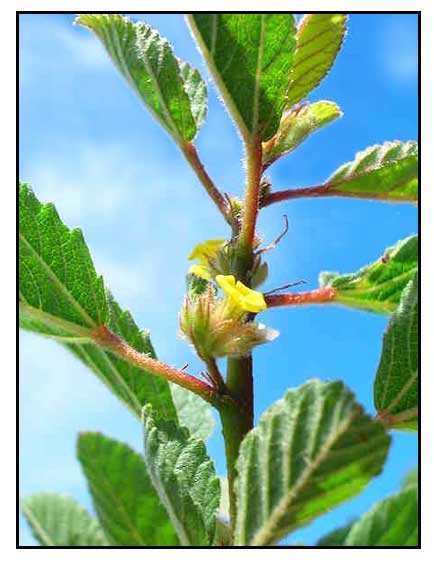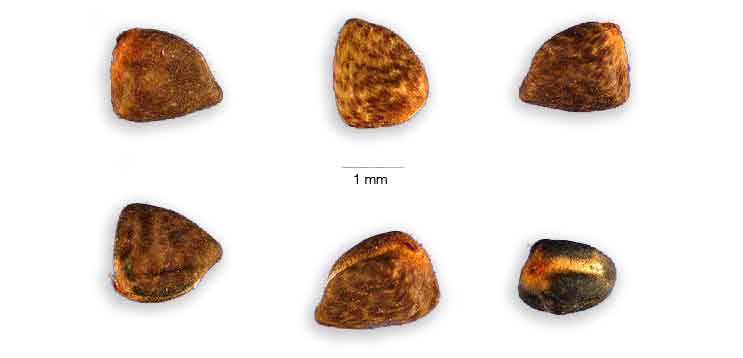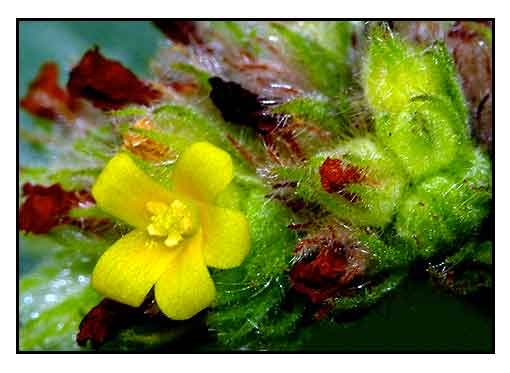 Botany Botany
Barulad is an erect, more or less branched, hairy, shrubby or half woody plant, 0.5 to 1.5 meters high. Leaves are oblong-ovate or oblong, 3.5 to 9 centimeters long, rounded or blunt at the tip, slightly heart-shaped at the base, with toothed margins. Flowers are yellow, sweet-scented, about 5 millimeters long, borne in dense, shortly peduncled fascicles at the axils of the leaves.
Distribution
- A common weed in dry places in the settled areas of the Philippines at low and medium altitudes.
- Pantropic.
Constituents
- Yields mucilage, tannin and sugar; no alkaloid.
- Phytochemical screening yielded alkaloids, terpenes, flavonoids, tannins, glycosides, sterols, saponins, anthraquinones, and carbohydrates.
- Phytochemical screening yielded flavonoids (−)- epicatechin, quercetin, kaempferol, and kaempferol-3-O-ß- D-(6" -E-p-coumaroyl)-glucopyranoside
- Extract fractionation isolation of three alkaloids adouetin X (1), waltheriones A (2) and C (3)) and three pentacyclic triterpene derivatives (betulinic acid (4), 3β-acetoxy-27-trans-caffeoyloxyolean-12-en-28-oic acid methyl ester (5) and 3β-acetoxy-27-cis-caffeoyloxyolean-12-en-28-oic acid methyl ester (6)) identified by 1D and 2D NMR, UV, IR and MS analysis.
(see study below) (19)
- Phytochemical screening of various extracts of air-dried plant yielded flavonoids, anthraquinones, saponins, tannins, terpenes, cardiac glycosides, and carbohydrate, with absence of free anthraquinone and phlobatannins. (see study below) (24)
- Fractionation of root extracts isolated 12 quinolone alkaloids viz., 8-deoxoantidesmone (1), waltheriones A and C (2,3), waltheriones E-K (4-10), 1-demethoxy-4-methoxy-waltherione G-N-oxide (11), and antidesmone (12) (see study below)
(27)
- GC-MS analysis of ethanol extract of leaves yielded 27 bioactive compounds. Major compounds were identified as 2,3-dihydro-3,5-dihydro-6-methyl-4h--pyran-4-one, tetradecane, nonadecane, tetracosane, phytol and squalene. (31)
- Study of aerial parts isolated 16 compounds: fiver terpenoids (1-5), four coumarins (6-9), six flavonoids (10-15), and one phenylpropanoid glycoside (16).
(34)
 Properties Properties
- Plant considered astringent.
- Mucilaginous.
- Considered emollient, febrifuge, anti-inflammatory, antifungal, antisyphilitic, aphrodisiac, abortifacient.
- Root considered purgative.
- Studies have suggested anti-inflammatory, anti-pneumococcal, antioxidant, antimicrobial, anti-plasmodial, anti-trypanosomal, wound healing, anti-cataract, cytotoxic, anti-ulcer, analgesic, chemopreventive properties.
Parts used
Roots, leaves.
 Uses Uses
Folkloric
- In the Philippines, used as febrifuge and as antisyphilitic.
- In Tamaulipas,decoction used as remedy for eruptions of the skin; in Colima, used for washing wounds.
- Decoction given to infants to drink or to sniff and inhale, at teething or at birth.
- In Togo and Yoruba, infusion is given as drink and wash, to strengthen a child's resistance against fevers.
- Among the Hausas. used as purgative; decoction used as syphilis prevention or immunity.
- Used by farmers as a restorative drink during the labors of harvesting.
- In Togo, spoonful of the pulverized plant in hot water, taken morning and evening as cough medicine.
- In Surinam, used as febrifuge.
- In Guadalupe, used as febrifuge and antisyphilitic.
- In the Gold Coast, used as abortifacient, but in South Africa, root used as remedy for sterility and as astringent for internal hemorrhages.
- In the Antilles, used as emollient.
- In West Africa, decoction of roots and leaves, used for washing wounds. In the Ivory Coast, decoction of roots also used as aphrodisiac.
- In Nigeria, decoction of roots or chewing of fresh roots used for internal hemorrhage. Boiled leaves taken for contraception. (11)
- In Burkina Faso, roots and aerial parts used for treatment of malaria. (27)
- Used in African folklore medicine for treatment of pain, fever, rheumatism.
(32)
- In India, decoction of dry leaf powder
used for cough. (33)
Others
- Cosmetics: Extract has reported use in several cosmetic products – moisturizers, skin lightening, anti-aging.
- Ethnoveterinary: In Niger/Nigeria, herdsmen use the whole plant as tonic for cattle. (27)
Studies
• Anti-Inflammatory / Flavonoids: Study isolated three flavonoids from the whole plant of Waltheria indica. The flavonoids showed significant dose-dependent inhibition of the production of inflammatory mediator NO, cytokines (TNF-a) and interleukin (IL-12) in activated macrophages, without displaying cytotoxicity. Findings support the use of W indica for inflammatory diseases. (1)
• Anti-Pneumococcal: Study of 221 crude extracts from 17 species showed 7 from 6 plants, including Waltheria indica, to have promising in vitro bactericidal activity against Pneumococcus, including penicillin-resistant strains. Results support its traditional use in the treatment of pneumococcal infections. (2)
• Anti-Plasmodial: In a study of 13 extracts from 8 different species, five species, including W indica (roots and aerial parts) demonstrated moderate antiplasmodial activity. (3)
• Flavones / Antifungal: Study yielded two flavones, 5,2,5'trihydroxy-3,7,4' trimethoxyflavone and 5,2'dihydroxy-3,7,4',5' tetramethoxyflavone. Both were exclusively very active against fungal microorganisms: Aspergillus niger, Candida albicans, and T. mentagrophytes. (5)
• Antibacterial / Roots: Study evaluated the antibacterial activity of methanolic extracts of W. indica roots. Results showed inhibitory activity against 91.7% of 180 clinical isolates. In toxicity studies, the LD50 of the extracts was more than 2000 mg kg. (6)
• Anti-Trypanosomal / Roots: Study evaluated the inhibitory activity of W. indica extracts against Trypanosoma brucei brucei, the causative parasite of trypanosomiasis. Results showed an ethanol extract was the most active, with the petroleum ether extract showing moderate activity against the trypanosome parasites. (8)
• Wound Healing / Antibacterial / Roots: Study evaluated the wound healing efficacy of Punica granatum peels and Waltheria indica roots against six standard organisms. The methanolic extract of W indica roots showed high antibacterial activity with inhibitory effect against 91.7% of the isolates at concentration of 100 mg/ml. Results showed the ointment formulations to be potent healing agents. (9) (15)
• Antioxidant / Antimicrobial: Study evaluated shoot extracts of Waltheria indica and Mucuna pruriens for antioxidant and antimicrobial activities. n-Hexane extracts showed the best DPPH radical scavenging activities, while ethanol extracts showed the best antimicrobial activities against Salmonella typhi, B. subtilis, Streptococci, E. coli, Aspergillus niger, A. flavus, and Candida albicans. (10)
• Cytotoxicity / Radical Scavenging / Stems and Leaves: Study evaluated various extracts of stems and leaves for radical scavenging and cytotoxicity. Among the extracts, methanol showed the stronger reducing power in the FRAP assay. Extracts also showed cytotoxicity towards normal Vero and cancer cell lines (HaCaT, A549, HeLa, HT-29) on MTT assay. (11)
• Anti-Cataract: Study evaluated the anticataract ability of Waltheria indica in rats. Acute toxicity study showed no abnormalities or mortality even at maximum tolerated dose level of 2000 mg/kbw po. Biochemical changes reiterate the role of oxidative stress in cataractogenesis. Findings showed WI tweaks antioxidant parameters, attenuates and defers the onset and progression of Naphthalene induced cataract. (16)
• Effect on Trypanosoma brucei Parasitaemia and Glucose Level: Study evaluated the effect of WI on parasitaemia and glucose level of Trypanosoma brucei infected rats. The ethanol extract of WI dose and time dependently inhibited parasitaemia extending life from 8.5 days to 30.3 days, and also significantly and dose dependently improving the hypoglycemic stage of infected animals. (17)
• Effect on-Reproductive Indices: Study evaluate the effect of a leaf extract of WI on reproductive parameters of male albino rats. There was a significant decrease in sperm motility and sperm counts, decreased live-dead ration and an increase in total abnormal cells, together with periportal cellular infiltration and interstitial congestion of the testes. (18)
• Alkaloids / Anti-Trypanosomal: Study screened roots and aerial parts of W. indica for in vitro anti-trypanosomal activity towards T. brucei and T. cruzi. Extract fractionation isolated three alkaloids and three pentacyclic triterpene derivatives. Waltherione C exhibited the highest and selective antitrypanosomal activity towards T. cruzi and low cytotoxicity. (see constituents above) (19)
• Cancer Chemopreventive / NF-kB inhibitors and QR inducing Compounds / Aerial Parts: Transcription factor NF-kB is known to induce tumor promotion and progression and is a major factor in inflammation-driven cancers. Study sought to confirm the use of Waltheria indica as traditional anti-inflammatory remedy by assessing the NF-kB inhibitory activity. Isolated compounds were tested for QR inducing property, a complementary strategy in cancer chemprevention that targets tumor initiation. A dichloromethane extract yielded 29 compounds and tested for chemopreventon activity, of which 11 inhibited NF-kB and/or induced QR in low to mid µM range. Chrysosplenol E (20) was active in both tests. Waltherione A and Waltherione C were two of the most potent NF-kB inhibitors. (20)
• Antibacterial / Toxicological Study / Roots: Study isolated 180 clinical isolates from diabetic wound infection: 30 E. coli, 15 Klebsiella pneumonia, 45 Proteus sp., 15 Pseudomonas aeruginosa 60 S. aureus and 15 S. epidermis Cup-plate method showed 91.7% inhibitory effect against the isolates. Toxicity study showed an LD50 of more than 2000 mg/kg. (21)
• Anti-Inflammatory / Inhibition of Inflammatory Cytokines and Cytokine Receptors: Study demonstrated the Waltheria indica extracts inhibit key inflammatory cytokines and cytokine receptors including protein levels of IL-1B, IL-1ra, IL-8, and IL-6, reduce both mRNA and protein levels of TNF-α and protein levels of its receptor, TNF RII, to effectively diminish activities of multiple pro-inflammatory signaling pathways and mitigate key processes in diseases with inflammatory components. (22)
• Anti-Inflammatory / Leaves: Study evaluated petroleum ether and methanol extracts of W. indica for anti-inflammatory activity using in-vivo carrageenan and histamine induced rat paw edema, cotton pellet granuloma test models. All extracts showed significant activity at dose of 500 mg/kbw orally. (23)
• Antimicrobial / Leaves: Study of various extracts of air-dried powdered plant showed remarkable activity against Escherichia coli and Staphylococcus aureus. (see constituents above) (24)
• Antioxidant / Analgesic / Anti-Inflammatory / Leaves: Study of various leaf extracts of W. indica showed invivo anti-inflammatory and analgesic activity using models of carrageenan induced edema, acetic acid induced pain, respectively, and invitro antioxidant activity by DPPH radical scavenging and lipid peroxidation. (25)
• Hepatotoxicity with High Doses / Leaves: Study evaluated an aqueous extract of Waltheria indica leaf for effect on blood profile of male albino rats. The extract showed insignificant difference in packed cell volume, MCV, MCHC, and Hb concentrations. However, it showed significant increase (p<0.01) in values of ALT and AST, BUN and creatinine at 800 and 2000 mg/kg doses, along with periportal cellular infiltration and diffuse hydropic degeneration of hepatocytes. Results suggest caution with use of W. indica leaf at high doses because of possible hepatotoxicity. (26)
• Antitrypanocidal Activity / Quinoline Alkaloids / Roots: Study evaluated extracts of W. indica roots for activity against protozoa from genera Trypanosoma, Leishmania and Plasmodium. Fractionation isolated 12 quinolone alkaloids. Compounds 6, 7, and 10, showed potent and selective growth inhibition towards Trypanosoma cruzi with IC50s between00.02 and 0.04 µM, significantly lower than reference drug benznidazole (2.22 µM). Compound 3 showed trypanocidal activity with IC50 1.93 µM resulting ion a selectivity index (IC50 L-6/IC50 T. cruzi) superior to 50, The alkaloid conforms to activity criteria for T. cruzi as required by the WHO/TDR. (see constituents above) (27)
• Adverse Reproductive Effects / Roots: Study evaluated the effect of crude ethanolic extract of Waltheria indica roots on male reproductive parameters. Results showed a significant reduction in sperm count and motility as well as a significant increase in percentage of abnormal sperm cell (p<0.001) and 400 and 800 mg/kbw. There was also a significant reduction of serum testosterone levels along with significant increase in total cholesterol (p<0.05) at highest dose. (28)
• Antidiabetic / Antioxidant / Lipid Benefits: Study evaluated the antidiabetic activity of methanolic extract of whole plant and its effect on lipid profile, antioxidant properties and liver and kidney histopathology in alloxan induced diabetic models. Results showed dose dependent anti-diabetic effect which was attributed to increased uptake of glucose at the tissue level. There was also a significant increase in HDL SOD, CAT, reduced GSH and GPx, a significant decrease in TC, TG, LDL, and VLDLÂ . (29)
• Cytotoxicity / Antioxidant / Leaves: Study evaluated the cytotoxic effect of chloroform extracts of W. indica leaves on cervical cancer cells. Results showed dose dependent cytotoxic effect in HeLa cell line with CTC50 of 103.33 ± 3.77 for MTT assay and 90.00 for Tryptan blue dye test. Dying cells showed characteristics of apoptosis such as DNA fragmentation. Results clearly showed cytotoxic effects on human cervical cancer cells. (30)
• Antinociceptive / Anti-Inflammatory / Leaves: Study of methanol extract of leaves showed no mortality in mice up to 2,000 mg/kbw. The extract at 100 or 200 mg/kg produced inhibition (p<0.05) both in formalin-induced paw licking and acetic acid induced writhing tests. In thermal test, there was significant increase in withdrawal latency There was reversal of analgesic effect with cholinergic and opioidergic blockers. The extract produced dose-related inhibition of cotton pellet induced granuloma in rats and carrageenan induced paw edema in rats. (32)
• Antiulcer/ / Leaves: Study evaluated the antiulcer activity of aqueous extract of W. indica leaves against pyloric ligated rat ulcer model. Results showed significant anti-ulcer with significant decrease in the ulcer index. (35)
• Comparative Proximate and Nutrient Composition of Leaves, Roots and Stems: Study of different parts of W. indica plant (leaves, root, and stems) showed significant differences (p<0.001) in content of crude protein, crude fat, ash, carbohydrates = and gross energy. Leaves showed highest amounts of mineral. Study concluded that the leaf part of Waltheria indica is the most nutritious and least in antinutritional factors. (36)
Availability
Wild-crafted.
Tinctures and extracts in the cybermarket.
|

![]()




 Properties
Properties
